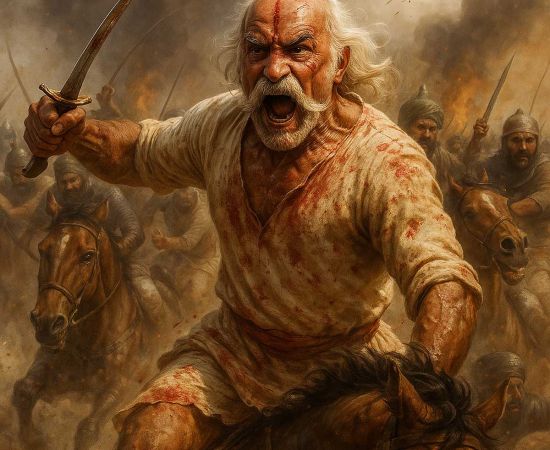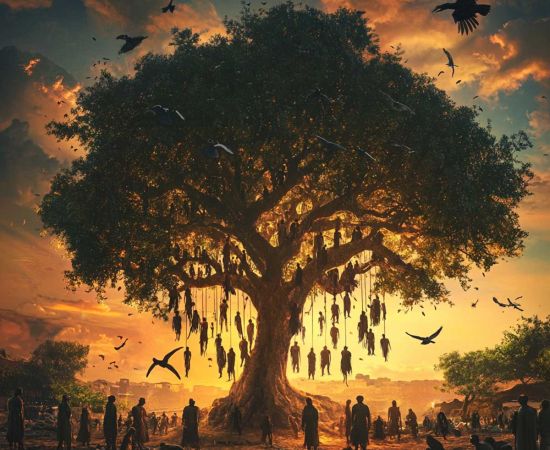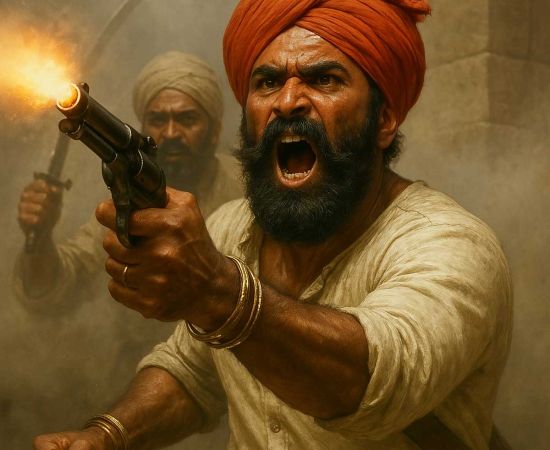MORE COVERAGE
Twitter Coverage
Satyaagrah
Written on
Satyaagrah
Written on
Satyaagrah
Written on
Satyaagrah
Written on
Satyaagrah
Written on
JOIN SATYAAGRAH SOCIAL MEDIA
"Temple Falls, Hope Crumbles": Demolition of Hinglaj Mata Mandir in Pakistan is a grave assault on Hindu heritage, this act of intolerance strips away not just a temple, but a rich tapestry of history and faith, deeply wounding the minority community

Pakistan's record on safeguarding minority rights remains a matter of international concern. In a recent alarming development, the country's authorities have demolished the Hinglaj Mata Mandir, a Hindu temple in Sindh province, along with the Sharda Peeth Mandir near the Line of Control. This act is seen as a continuation of Pakistan's long-standing issue with protecting the interests of its minority populations, particularly Hindus.
The demolition of the Hinglaj Mata Mandir in the Tharparkar District of Sindh has drawn significant attention and criticism. It's reported that the local authorities, citing a court order, carried out the destruction of this sacred Hindu site located in the city of Mithi. This act not only represents a physical loss but also symbolizes a deeper disregard for the religious sentiments and rights of the Hindu community in Pakistan. The temple, which held historical and spiritual significance for many, is now reduced to rubble, leaving behind a void in the hearts of its devotees and observers worldwide.
Former cricketer Danish Kaneria, himself a member of the Hindu community in Pakistan, took to social media to voice his distress over these events. His tweet highlights a grim reality: "Pakistani authorities continue crackdown on Hindu religious places. Following an order of anti-encroachment court Mirpurkhas, Hinglaj Mata Mandir has been demolished in Mithi, Tharparkar, Pakistan." Kaneria's words not only express his personal anguish but also serve as a call to action for those who stand for religious freedom and human rights.
|
The demolition of Hinglaj Mata Mandir isn't an isolated incident but part of a troubling pattern where Hindu temples in Pakistan have faced systematic targeting and destruction. Such actions not only violate international human rights norms but also deepen the wounds of religious intolerance and sectarianism. For a country striving to project an image of moderation and progressiveness on the global stage, these actions strike a dissonant chord.
This incident demands more than just fleeting attention; it calls for a robust response from the international community to safeguard the rights and freedoms of religious minorities in Pakistan. It underscores the urgent need for systemic change in how Pakistan addresses religious diversity and protects minority places of worship. The destruction of Hinglaj Mata Mandir is a stark reminder of the ongoing challenges faced by religious minorities in many parts of the world and the continuous fight for their right to exist, practice, and preserve their religious heritage.
|
Continued Destruction of Hindu Temples in Pakistan: Hinglaj Mata Mandir and Sharda Peeth Mandir Face Dire Threats
In a distressing continuation of events, the destruction of Hindu temples in Pakistan is gaining increasing attention and condemnation. The Hinglaj Mata Mandir, a temple of significant importance to the Hindu community, was demolished in the city of Mithi, Tharparkar District, under the guise of a court order. This move has raised serious questions about the legal frameworks being used to justify such actions.
Compounding the situation is the encroachment on Sharda Peeth Mandir, a site of immense historical and religious significance, recognized as a UNESCO site. Despite a standing Supreme Court order aimed at protecting this temple, it has not been spared from encroachment and desecration. The Sharda Peeth Mandir, located near the Line of Control, stands as a testament to the rich cultural heritage shared by people across borders, making its current state all the more tragic.
Ravinder Pandita, the Founder of the Save Sharda Committee Kashmir, expressed his dismay on social media over the condition of Sharda Peeth Mandir. His tweet paints a grim picture: "Disturbing visuals from Sharda peeth PoK. Disheartened to see the peripheral wall of our Sharda sarvagnya peeth across LoC in Distt.Neelum broken and stones thereof carted away. Further there are some more encroachments going on.
|
Revealed by our civil society members across LoC during their recent visit. Whole world should notice it particularly Pak army who is guarding it since a long. The Pak army bunker/station didn't exist up to 2016 & it came up in early 2017." This statement not only highlights the physical damage inflicted on the temple but also raises critical questions about the role of the Pakistan Army in these developments.
Adding to the controversy, locals have reported that the Pakistan Army has constructed a coffee house near the Sharda Peeth Mandir, an act perceived as a blatant disregard for the sanctity of the site. This development has sparked strong protests from the local community and beyond, as it represents not just an encroachment on physical space but also on the spiritual and cultural identity of the Hindu community.
The situation surrounding both Hinglaj Mata Mandir and Sharda Peeth Mandir is indicative of a broader issue of minority rights and religious freedoms in Pakistan. These incidents are not merely about the destruction of physical structures; they symbolize an assault on the religious and cultural heritage of a community. They call for a concerted effort by international bodies and human rights organizations to address the ongoing violations of religious freedoms and to hold accountable those responsible for such acts.
Hindu community has faced persistent challenges, including targeted violence, killings, and encroachments on their lands. Local involvement in these acts, often followed by government endorsement, has been a recurring pattern. And, such incidents underscore the ongoing persecution faced by Hindus in the country. The attacks on Hindu temples in Pakistan are not a new occurrence. Danish Kaneria had previously reported an attack on a Hindu temple in Karachi last year.
The plight of these temples and the communities attached to them is a stark reminder of the need for vigilance and advocacy in protecting the rights and freedoms of minority groups worldwide. It underscores the importance of international attention and intervention in situations where local authorities fail to uphold the principles of religious tolerance and cultural preservation.
|
About Hinglaj Mata Mandir: A Sacred Site Amidst Persecution
The Hinglaj Mata Mandir, a revered Hindu temple in Pakistan, stands as a beacon of spiritual significance amid the turmoil faced by the Hindu community in the country. This temple, also known as Hinglaj Devi, Hingula Devi, and Nani Mandir, is located in the town of Hinglaj on the Makran coast in the Lasbela district of Balochistan. It is nestled within the confines of the Hingol National Park, presenting a blend of natural beauty and spiritual solace.
Hindu temples in Pakistan, including the Hinglaj Mata Mandir, have faced persistent challenges. The Hindu community has been subjected to targeted violence, killings, and encroachments on their lands. Often, these acts involve local participation, followed by government endorsement, highlighting a disturbing pattern of persecution against Hindus in the country. The destruction and desecration of Hindu temples, including the recent demolitions of Hinglaj Mata Mandir and Sharda Peeth Mandir, are reflective of this grim reality.
The Hinglaj Mata Mandir holds immense significance as one of the 51 Shakti Peethas in the Shaktism denomination of Hinduism, with only three of these sacred sites located in Pakistan. The temple is uniquely positioned along the Hingol River in Balochistan, about 217 kilometers from Karachi. Accessing the temple is a testament to the devotees' faith, as it requires navigating challenging desert terrain, symbolizing the arduous journey of devotion and spiritual quest.
Remarkably, the Hinglaj Mata Mandir deviates from conventional Hindu temple architecture. Situated within a natural cave, it houses a low mud altar without a man-made image of the goddess. Instead, a small divine form of Hinglaj Mata, represented by a stone adorned with sindoor, is revered. This distinct feature underscores the temple's deep-rooted connection with nature and the divine.
The temple's location in a remote, hilly area of Lyari Tehsil in Balochistan, within a narrow gorge, adds to its mystical allure. Surrounded by the Kirthar Mountains and the Makran desert stretch, the temple sits along the west bank of the Hingol River, enveloped by the rugged beauty of its natural surroundings.
|
Beyond the Hinglaj Mata Mandir, the area is home to other significant places of worship, including Ganesh Deva, Mata Kali, Gurugorakh Nath Dooni, and several more, each contributing to the region's rich tapestry of spiritual heritage. These sites not only serve as places of worship but also as symbols of the enduring spirit of the Hindu community in a region where their existence is continually challenged.
The plight of the Hinglaj Mata Mandir and other Hindu temples in Pakistan is not just a matter of religious concern but also a human rights issue. The international community must recognize and respond to the ongoing persecution and marginalization of the Hindu community in Pakistan. Preserving these temples is crucial, not only for the sake of religious freedom but also for the protection of cultural and historical heritage that they embody.
Significance
Hinglaj Mata, revered as a powerful deity in Hinduism, bestows blessings upon her devotees. Her primary temple, the Hinglaj Mata Mandir, is not the only shrine dedicated to her; there are temples in the neighboring Indian states of Gujarat and Rajasthan as well. Known by various names in Hindu scriptures, particularly in Sanskrit, she is referred to as Hinglaj Mata (the Mother Hinglaj), Hinglaj Devi (the Goddess Hinglaj), Hingula Devi (the red goddess or the Goddess of Hingula), and Kottari or Kotavi.
The chief legend associated with Hinglaj Mata is intricately linked to the creation of the Shakti Peethas. The story revolves around Sati, the daughter of Prajapati Daksha, who married Lord Shiva against her father's wishes. When Daksha held a great yajna, he neither invited Sati nor Shiva. Defying this exclusion, Sati attended the yajna only to find herself and Shiva insulted by her father. Unable to bear this disrespect, Sati immolated herself, activating her chakras through her anger. Following her death, Lord Shiva, in his grief and rage, decapitated Daksha, though he later resurrected him. As Shiva wandered the universe carrying Sati's corpse, Lord Vishnu dismembered her body, with the parts falling at various locations that became known as Shakti Peethas. The Hinglaj Mata Mandir is believed to be where Sati's head fell, making it a site of immense religious importance.
|
In Other Scriptures
The Hinglaj Mata Mandir's significance is further emphasized in various Hindu scriptures. The Kularnava Tantra lists it as the third among 18 Pithas, while in the Kubjika Tantra, it ranks fifth among 42 Shakta or Siddha Pithas. The Pithanirnaya section of the Tantrachudamani, which originally listed 43 Pithas but expanded to 51 over time, places Hingula or Hingulata at the top of the list. Here, the goddess is associated with Brahmarandhra (a suture in the crown of the head) and is known by several names, including Kottari, Kottavi, and Kottarisha, with the Bhairava (male counterpart) being Bhimalochana. Similarly, in the Shivasharitha, Hingula holds a prominent position among 55 Pithas.
Furthermore, in the 16th-century Bengali work Chandimangal, the author Mukundaram lists Hinglaja as the last Pitha, where Sati's forehead is said to have fallen. This places Hinglaj Mata Mandir not just in the realm of religious reverence but also in the heart of Hindu mythological and cultural narratives.
Another legend associated with the temple involves the goddess defeating a demon named Hingol, who tormented the people. Upon following Hingol to a cave, the present site of the Hinglaj Mata shrine, the goddess granted his dying wish to name the place after him. This legend further adds to the mystique and sacredness of the site, illustrating the temple's deep-seated roots in mythological lore and its significance as a center of divine power and benevolence.
The Hinglaj Mata Mandir thus stands not just as a physical structure but as a symbol of faith, history, and mythology, embodying the spiritual journey and devotion of countless followers over centuries. Its significance transcends geographical boundaries, weaving a rich tapestry of belief, tradition, and reverence deeply embedded in the collective consciousness of Hindu devotees worldwide.
|
Belief of Brahmakshatriyas
The Brahmakshatriya and Charan communities, also known as Gadhvi, hold Hinglaj Mata in high esteem as their family deity. Their veneration is rooted in a legend involving the Hindu god Parashurama, known for his persecution of the Kshatriyas (the warrior caste). According to their belief, when Parashurama was on his mission to eliminate Kshatriyas, some Brahmins (the priest caste) came to the rescue of 12 Kshatriya warriors. These Brahmins provided shelter and disguised the warriors as members of their own caste, under the protection of Hinglaj Mata.
A variation of this tale involves the sage Dadhichi, who sheltered Ratnasena, a king from Sind, in his ashram (hermitage). Despite the sage's protection, Ratnasena was slain by Parashurama. His sons, however, remained safe in the ashram. When Parashurama visited, they were disguised as Brahmins. One of these sons, Jayasena, later returned to Sind to rule, equipped with a protective mantra of Hinglaj Mata bestowed by Dadhichi. The deity protected Jayasena and commanded Parashurama to cease his crusade against the Kshatriyas. This narrative highlights the role of Hinglaj Mata as a protector and a divine benefactor for the Brahmakshatriya community.
|
Belief as Kuldevi
The story of Hinglaj Mata as Kuldevi (family deity) is interwoven with the lore of Treta Yuga. A king named Sahasrabahu Arjuna, also known as Kartavirya Arjuna, ruled the Malwa region. Intoxicated by his own power, he committed a grave sin by killing the revered Brahman sage Jamadagni over the sacred cow Kamadhenu. Enraged by this act, Jamadagni's son, Lord Parashurama, vowed to eradicate the Kshatriya clan from Earth. He embarked on a mission, destroying unvirtuous and unworthy kings, leading to a reign of terror across the kingdoms.
Fearing Parashurama's wrath, the descendants of Sahasrabahu Arjuna sought refuge under Janaka Maharaj, the wise king of Videha. He advised them to seek the blessings of Hinglaji Mata. Upon reaching Hingloj, they prayed to the Devi, who, moved by compassion, granted them shelter. During a visit by Lord Parashurama, he found the Kshatriya clan engaged in Brahminical activities and disarmed. Hinglaj Mata interceded on their behalf, resulting in Parashurama teaching them scriptures, Vedas, and the art of weaving as a means of livelihood.
This led to the clan branching out across regions like Sindh, Punjab, Rajasthan, Madhya Pradesh, Telangana, Maharashtra, Andhra Pradesh, and Karnataka, continuing their worship of Hinglaj Devi. The Charans, also known as Gadhvi, Khatris, Bhavasars, Barots, and Shimpis of Somavaunsha Sahasrarjun Kshatriya, trace their origins to this clan. Interestingly, some who remained in Sindh later converted to Islam but are noted for being among the oldest non-Brahmin clans with knowledge of the Vedas. Many from this lineage still work as weavers and tailors, upholding the legacy passed down by Lord Parashurama.
The legends surrounding Hinglaj Mata not only highlight her significance as a deity but also underscore her role in shaping the cultural and social dynamics of various communities. Her influence extends beyond religious realms, touching upon the history, traditions, and livelihoods of those who revere her.
|
Veneration of Hinglaj Mata by Muslims
The reverence for Hinglaj Mata transcends religious boundaries, as evidenced by the respect she garners from the local Muslim community, particularly the Zikri Muslims. They too hold the Hinglaj Mata shrine in high regard and contribute to its security, referring to it as the "Nani Mandir" (literally, "maternal grandmother's temple"). This unique blend of Hindu and Muslim devotion at a single shrine is a testament to the syncretic nature of religious practices in the region.
The pilgrimage to the Hinglaj Mata shrine, known as the "Nani Ki Haj," sees participation from both Muslim and Hindu communities. This shared spiritual journey reflects a deep-rooted cultural harmony and mutual respect, transcending the often rigid boundaries of religion.
Sufi Muslims, known for their mystical approach to Islam, also hold Hinglaj Mata in high esteem. The renowned Sufi saint Shah Abdul Latif Bhittai not only visited the temple but also commemorated it in his poetry. The "Sur Ramkali" composed by Shah Abdul Latif Bhitai is a reverential ode to Hinglaj Mata and the visiting jogis (ascetics). A legend recounts that during his visit, Shah Abdul Latif Bhittai offered milk to the Hinglaj Mata and, in a miraculous vision, the deity appeared before him. Such stories highlight the spiritual connection and reverence that transcend conventional religious divides.
|
|
Annual Pilgrimage (Hinglaj Yatra or Theerth Yatra)
The annual pilgrimage to the Hinglaj Mata Temple, known as Hinglaj Yatra or Theerth Yatra, is a profound display of devotion and ritual. Once arriving in Hinglaj, pilgrims engage in a series of rites, including ascending the Chandragup and Khandewari mud volcanoes. Here, they perform acts of devotion like throwing coconuts into the volcano craters to make wishes or to express gratitude for prayers answered. Others scatter rose petals or anoint themselves with clay as a sign of reverence.
The ritual bath in the sacred Hingol River is another significant aspect of this pilgrimage, symbolizing purification before approaching the divine. The major ceremony takes place on the third day of this four-day journey, when priests invoke the gods to bless the offerings brought by pilgrims. These offerings often consist of three coconuts, a symbolic gesture of devotion and respect.
Historically, the pilgrimage was a challenging endeavor, involving a taxing trek of over 160 miles through desolate desert landscapes to reach the temple. However, recent infrastructural developments have facilitated easier access to the site, allowing an unprecedented number of pilgrims to participate in these age-old rituals.
Pilgrims traditionally commence their journey from the Nanad Panthi Akhada in Karachi, led by a chaadiar (holy staff bearer) authorized by the Akhada. The sadhus (holy men) accompanying the pilgrimage are Hata yogis, known for their cohesive group dynamics and ancestral genealogy. They also partake in secret rites, adding a layer of mysticism to the pilgrimage.
This annual pilgrimage is not just a journey of physical endurance but also a spiritual quest, uniting people from diverse backgrounds in their common devotion to Hinglaj Mata. It serves as a reminder of the enduring power of faith and the capacity of religious practices to bridge communal divides. The Hinglaj Yatra stands as a symbol of the enduring human spirit in search of the divine, a journey that resonates with people across different faiths and cultures.
 Support Us
Support Us
Satyagraha was born from the heart of our land, with an undying aim to unveil the true essence of Bharat. It seeks to illuminate the hidden tales of our valiant freedom fighters and the rich chronicles that haven't yet sung their complete melody in the mainstream.
While platforms like NDTV and 'The Wire' effortlessly garner funds under the banner of safeguarding democracy, we at Satyagraha walk a different path. Our strength and resonance come from you. In this journey to weave a stronger Bharat, every little contribution amplifies our voice. Let's come together, contribute as you can, and champion the true spirit of our nation.
 |  |  |
| ICICI Bank of Satyaagrah | Razorpay Bank of Satyaagrah | PayPal Bank of Satyaagrah - For International Payments |
If all above doesn't work, then try the LINK below:
Please share the article on other platforms
DISCLAIMER: The author is solely responsible for the views expressed in this article. The author carries the responsibility for citing and/or licensing of images utilized within the text. The website also frequently uses non-commercial images for representational purposes only in line with the article. We are not responsible for the authenticity of such images. If some images have a copyright issue, we request the person/entity to contact us at satyaagrahindia@gmail.com and we will take the necessary actions to resolve the issue.
Related Articles
- Muslim fundamentalists are not afraid of the Supreme Court of Pakistan and the government, demolished famous Hinglaj Mata Mandir in Pakistan: 11th attack in 22 months by religious fanatics
- Founder of 'The Wire' and 'The Print' had a melodramatic meltdown while objecting to meat ban during Navratri: How meat has been used as a political tool to hurt religious sentiments of Hindus during festivals
- Supreme Court allows same Muslim brothers to rent temple properties who have wrecked mayhem in Srisailam temple
- "Gyanvapi Dispute Escalates": The Anjuman Intezamia Masjid Committee challenges the ASI Survey amidst claims of overlooked funding rules and procedural lapses, with relics hinting at a historic temple unearthed, the Varanasi court silences media buzz
- Narasimha Anjaneyar temple demolished in Tamil Nadu despite devotees best efforts to save it, places of worship of other religions are spared
- Murder case of Hindu Youth Kishan Bharwad took a far more sinister turn when a Pakistani political party link in the case is revealed: Hindus protest in Gujarat erupts
- Pakistani Media reporting abduction, forceful conversion as a consent marriage with the Muslim abductor in SIndh
- An ancient Mata Tripur Sundari temple located in a remote forest area was burnt down in Kulgam: Jammu & Kashmir Police tries to downplay the event saying it was a minor fire caused by 'diyas/arti’
- Missionaries cannot have freedom of expression to vilify others’ religious beliefs - Madras HC refused FIR quash on Catholic priest’s anti-Hindu hate speech
- Argue over cold food and extra onion and you will have Employees of Karim restaurant attack you with knives and rods: Kolkata
- Owaisi bole toh 'Peace', Narsinghanand bole toh 'hate speech': Owaisi played the victim and filed a complaint, leading to an FIR against ‘Dharma Sansad’
- Haji Abdul Majeed and Rajab arrested for plotting to unleash violence during the ongoing Hijab protests by Muslim girl students outside Kundapura college, knives recovered: Karnataka
- Devkinandan Thakur's statement is a slap in the face of the Islamist hoodlum from Hyderabad - “Many more Yogis and Modis standing in line…”
- Tales of Fraud, funding, forced religious conversion and insulting Hindu gods and goddesses after brainwashing: How tribals were converted to Islam in Gujrat - “Aapka paigam London pahucha diya hai, achha kaam ho raha hai"
- Direct Action Day triggers The Great Calcutta Killings: Kolkata Paid Its Lives To Create Pakistan



























